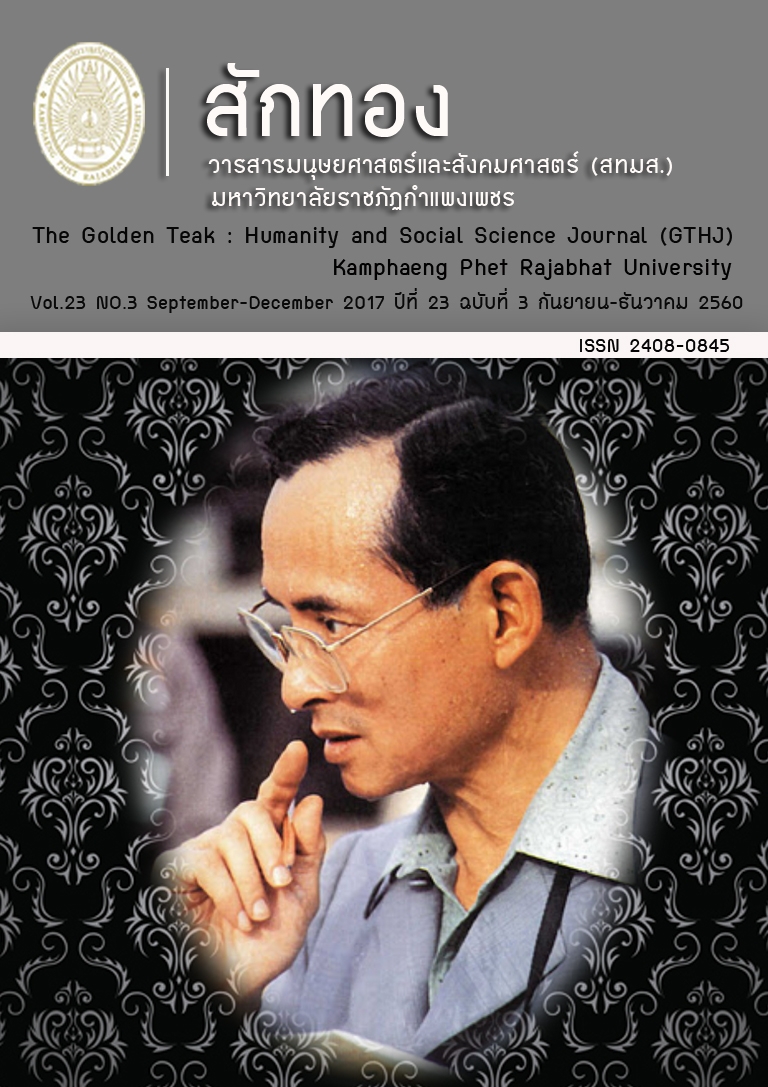กระบวนการจัดการความรู้ภูมิปัญญาท้องถิ่นหัตถกรรมผ้าปักชาวเขาสู่เศรษฐกิจ สร้างสรรค์ : กรณีศึกษากลุ่มชาติพันธุ์ชาวไทยภูเขาชนเผ่าม้งและเมี่ยน จังหวัดกำแพงเพชร
Main Article Content
Abstract
บทคัดย่อ
งานวิจัยมุ่งศึกษาภูมิปัญญาท้องถิ่น กระบวนการจัดการความรู้ และการพัฒนาภูมิปัญญาท้องถิ่นหัตถกรรมผ้าปักชาวเขาสู่เศรษฐกิจสร้างสรรค์ของกลุ่มชาติพันธุ์ชาวไทยภูเขาชนเผ่าม้งและเมี่ยน จังหวัดกำแพงเพชร การวิจัยนี้เป็นการวิจัยเชิงคุณภาพ (Qualitative Research) ผู้ให้ข้อมูลหลัก คือ สมาชิกกลุ่มผ้าปักชนเผ่าม้ง จำนวน 15 คน และชนเผ่าเมี่ยน จำนวน 30 คน โดยใช้การสำรวจชุมชน การสัมภาษณ์ การสนทนากลุ่ม การสังเกตแบบมีส่วนร่วมเป็นเครื่องมือในการวิจัย การวิเคราะห์ข้อมูลและนำเสนอข้อมูลตามหลักชาติพันธุ์วรรณาผลการศึกษาพบว่า ชนเผ่าม้งและเมี่ยนได้ย้ายถิ่นมาพื้นที่จังหวัดกำแพงเพชร เพราะการกระทำของมนุษย์ การแทรกแซงของพรรคคอมมิวนิสต์แห่งประเทศไทย และการประกาศเขตอุทยานแห่งชาติซ้อนทับพื้นที่ของหมู่บ้านชาวเขาเผ่าเมี่ยน จึงถูกขับไล่ออกจากพื้นที่ป่ามายังพื้นที่ราบทำให้ไม่มีที่ดินทำการเกษตร จึงต้องปรับตัวด้วยการนำอัตลักษณ์ทางวัฒนธรรมของตนมาสร้างสรรค์เป็นผลิตภัณฑ์เพื่อจำหน่าย งานสร้างสรรค์นี้คือ งานผ้าปักชาวม้ง ซึ่งมีลายผ้าอันเกิดจากการเลียนแบบธรรมชาติรอบตัว เช่น ลายดอกฝิ่น ดอกไม้ป่า เครือไม้ ก้อนหิน เสือ ช้าง หอย ปลา เป็นต้น สำหรับวิธีการปักผ้านั้นจะปักด้วยด้ายสลับสีเป็นลายไขว้ ปักทึบ เดินเส้น ลูกโซ่ และตัดผ้าปะเป็นลวดลายต่างๆ ส่วนชนเผ่าเมี่ยนมีการปักผ้าลายเจ้าสาว ทั้งที่เป็นกางเกงแบบสั้นและแบบยาว อีกทั้งมีลายผ้าประยุกต์ เพื่อนำชิ้นผ้าไปสร้างสรรค์ผลงานต่อไป ทางด้านองค์ความรู้ภูมิปัญญาท้องถิ่นผ้าปักชาวเขาถือว่ามีความจำเป็นต่อวิถีชีวิตตั้งแต่เกิดจนตาย การปักผ้าของชาวเขาเผ่าม้งและเมี่ยนนี้นอกจากจะช่วยสร้างรายได้แล้ว ยังมีการปักผ้าส่งศูนย์ศิลปาชีพ ซึ่งถือว่าเป็นการถ่ายทอดความรู้จากผู้หญิงรุ่นหนึ่งไปสู่อีกรุ่นหนึ่ง ส่วนกระบวนการจัดการความรู้ภูมิปัญญาท้องถิ่นของศูนย์หัตถกรรมผ้าปักชาวเขา ประกอบด้วย 6 ขั้นตอน คือ 1) การระบุความรู้ที่ต้องการ ตามความเชื่อของชนเผ่า เน้นคติด้านวัฒนธรรม ประเพณี ค่านิยมในท้องถิ่นที่ชาวบ้านมุ่งอธิบายตามปรากฏการณ์และสร้างสรรค์ลายผ้าปักเลียนแบบธรรมชาติรอบตัว 2) การจัดหาความรู้ที่ต้องการ การรับความรู้มาจากบรรพบุรุษ การแสวงหาความรู้การปักผ้าจากสมาชิกในครัวเรือน 3) การสร้างพัฒนาความรู้ใหม่ การถ่ายทอดความรู้จากบรรพบุรุษร่วมกันอย่างใกล้ชิด และการพัฒนาความรู้ที่มีในแต่ละบุคคลผนวกเข้ากับความรู้ในกลุ่มเครือญาติ การสร้างจากความเชื่อและความสัมพันธ์ของวิถีชีวิตความเป็นอยู่ และตามความต้องการของศูนย์ศิลปาชีพ 4) การถ่ายทอดความรู้ เป็นการถ่ายทอดความรู้ไม่ที่เป็นทางการตามธรรมชาติและไม่มีแบบแผนที่เป็นทางการ เกิดขึ้นจากการดำเนินชีวิตประจำวัน และการปฏิบัติหน้าที่ของผู้หญิงชนเผ่า5) การจัดเก็บความรู้ แลแลแลแ เก็บแบบลายผ้าปักหรือชิ้นผ้าเป็นความรู้ที่ฝังลึกอยู่ในตัวบุคคล ใช้วิธีการจดจำของแต่ละบุคคล ยังไม่มีการจัดเก็บความรู้ที่เป็นระบบ และไม่ได้บันทึกเป็นลายลักษณ์อักษร 6) การนำความรู้มาใช้ได้พัฒนาลายผ้าปักส่งศูนย์ศิลปาชีพ สืบทอดภูมิปัญญาปักผ้าของชนเผ่า และนำความรู้ถ่ายทอดให้แก่เด็กและเยาวชนผ่านเอกสารเผยแพร่ผ้าปักชาวเขา สู่สถานศึกษาที่อยู่ในชุมชนท้องถิ่น ส่วนการพัฒนาภูมิปัญญาท้องถิ่นหัตถกรรมผ้าปักชาวเขาสู่เศรษฐกิจสร้างสรรค์ มีการขับเคลื่อนกิจกรรมเชิงสร้างสรรค์ ด้วยการแสวงหาโอกาส มุ่งเน้นพึ่งพาตนเองบนฐานของศักยภาพและทรัพยากรทางวัฒนธรรม การสร้างมูลค่าจากการผลิตสินค้าผ้าปักชาวเขากระเป๋าสตางค์ พวงกุญแจ กระเป๋าเป้ รองเท้า มีนวัตกรรมและการประยุกต์ใช้เทคโนโลยี เพื่อสร้างมูลค่าเพิ่มให้แก่สินค้าที่ชนเผ่าผลิต การสร้างเครือข่ายด้านการพัฒนาต่อยอดเพิ่มคุณภาพสินค้า และการจัดการด้านการตลาด
Local Wisdom Knowledge Management Process of the Hill tribe Handicraft to Creative Economy : Case study of Hmong and Mien Ethnic Groups in Kamphaeng Phet Province
ABSTRACT
The main purposes of this research were to study the local wisdom of the hill tribe embroidery clothes, local wisdom knowledge management process of the hill tribe Handicraft, and to develop the local wisdom of embroidery which would create economy for the Hmong and Mien ethnic groups in Kamphaeng Phet province. The research was of qualitative methodology; the key informants were Hmong ethnic group which consist of 15 people and Mein ethnic group with 30 people. The major studying method was an application of a survey community, an interview, a focus group discussion, and a participant observation. Data analysis and presentation of data based on ethnographic research. The result showed that Hmong and Mien ethnic groups migrate to Kamphaeng Phet because of the biased government put the barrier with them not to live in the forest areas, and moves them to the lowland but not manages at all; do not have agricultural land. So, they have to adapt their cultural identity to create economy for distribution by themselves. The Hmong has created the embroidery clothes by natural imitation around them such as opium puppy flower, forest flowers, vine, stone, tiger, elephant, shell, and fish with embroidery clothes by crossing the color thread embroidery blinded, line embroidery, chain embroidery, and cutting on style of Hmong embroidery folk art tribal textile panel, but for Mien ethnic group, they embroidered the pattern style of a bride’s wedding, short pants and long pants, and making on adaptation with embroidery clothes to create products. Local wisdom of embroidery clothes knowledge is necessary on the way of life from birth to death. The embroidery for the Royal Folk Arts and Crafts Centre is considered a knowledge transfer from the women to women in the ethnic group from one generation to another generation; in addition, local wisdom knowledge management process of the hill tribe embroidery clothes is divided into 6 steps. First, focuses on how existed of the knowledge was needed. On the way of ethnic belief that focuses on culture, tradition, values available locally that people can describe with phenomenon and creates the style of embroidery clothes by imitation in daily life. Second, knowledge management which were needed by getting from the ancestor, seeking the embroidery clothes knowledge from ethnics groups or family. Third, development of a new knowledge, transfer knowledge from ancestors, personal development for joint venture into the relationship, belief and relationship of the living and creations which are needed for the Royal Folk Arts and Crafts Centre. Fourth, knowledge transfer is informal in nature and unofficial that occurs in daily life, and women of the ethnic group. Fifth, knowledge keeping, embroidery keeping or the pattern of clothes that were the tacit knowledge into personal knowledge by each personal keeping that has not managed systematically and has not written record, and lastly, to take the knowledge for development of the pattern style of embroidery to distribute to the Royal Folk Arts and Crafts Centre for transferring the local wisdom of the hill tribe ethnic groups. Moreover, the tacit knowledge has to distribute to the juveniles through the publication for schools in the local community. Development in the local wisdom of the hill tribe embroidery to create economy has driven on creative activity by seeking the opportunity and focuses on self-reliance based on the potential and cultural resources, valued creation of hill tribe products such as wallets, key chain, backpack and shoes. Innovation and technology should take for adding value to the hill tribe products, including building the net working to up devolvement in the products and marketing management.
Article Details
บทความที่ได้รับการตีพิมพ์เป็นลิขสิทธิ์ของวารสาร สักทอง : วารสารมนุษยศาสตร์และสังคมศาสตร์ สถาบันวิจัยและพัฒนา มหาวิทยาลับราชภัฏกำแพงเพชร
ข้อคิดเห็นใดๆ ที่ปรากฎในวารสารเป็นวรรณกรรมของผู้เขียนโดยเฉพาะ ซึ่งมหาวิทยาลัยราชภัฏกำแพงเพชรและบรรณาธิการไม่จำเป็นต้องเห็นด้วย


